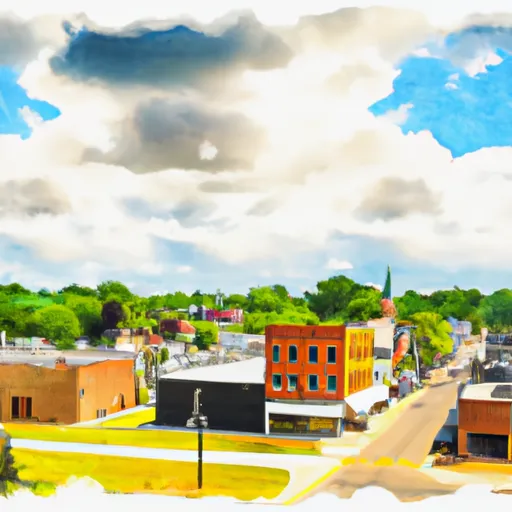-
 Snoflo Premium
Snoflo Premium
Get unlimited access to all our content
With no Ad interruptions! - Start Your Free Trial Login with existing account
Princeton
Eden Index
Climate
5.7
•
Recreation
0.6
•
Community
2.2
•
Safeguard
3.0/10

Princeton, Michigan, is a charming town located in the Lower Peninsula, known for its beautiful natural surroundings and outdoor recreation opportunities. The climate in Princeton is characterized by warm summers and cold winters. Average summer temperatures range from 70-80°F, while winter temperatures can drop to 20-30°F. The region experiences moderate rainfall throughout the year, with occasional snowfall during the winter months.
Princeton is blessed with a diverse hydrology, which adds to its allure. The town is nestled near several lakes, including Lake Michigan and Lake Huron, offering residents and visitors abundant opportunities for water-based activities such as fishing, boating, and swimming. Additionally, the area is dotted with numerous rivers and streams, making it popular for kayaking and canoeing enthusiasts.
Outdoor enthusiasts will find a plethora of recreational activities in Princeton. The town boasts several parks and nature reserves, providing opportunities for hiking, camping, birdwatching, and wildlife spotting. In the winter, residents can enjoy skiing, snowboarding, and snowshoeing at nearby resorts and trails. Princeton's stunning natural landscapes combined with its favorable climate make it an ideal destination for those seeking to embrace the great outdoors.
What is the Eden Index?
The Snoflo Eden Index serves as a comprehensive rating system for regions, evaluating their desirability through a holistic assessment of climate health, outdoor recreation opportunities, and natural disaster risk, acknowledging the profound impact of these factors on livability and well-being.
Climate Health Indicator (CHI): 5.7
Princeton receives approximately
786mm of rain per year,
with humidity levels near 83%
and air temperatures averaging around
6°C.
Princeton has a plant hardyness factor of
4, meaning
plants and agriculture in this region thrive during a short period during spring and early summer. Most
plants will die off during the colder winter months.
By considering the ideal temperature range, reliable water supplies, clean air, and stable seasonal rain or snowpacks, the Climate Health Indicator (CHI) underscores the significance of a healthy climate as the foundation for quality living.
A healthy climate is paramount for ensuring a high quality of life and livability in a region, fostering both physical well-being and environmental harmony. This can be characterized by ideal temperatures, reliable access to water supplies, clean air, and consistent seasonal rain or snowpacks.
Weather Forecast
Streamflow Conditions
Northwestern Lake Michigan
Area Rivers
Northwestern Lake Michigan
Snowpack Depths
Northwestern Lake Michigan
Reservoir Storage Capacity
Northwestern Lake Michigan
Groundwater Levels
Recreational Opportunity Index (ROI): 0.6
The Recreational Opportunity Index (ROI) recognizes the value of outdoor recreational options, such as parks, hiking trails, camping sites, and fishing spots, while acknowledging that climate plays a pivotal role in ensuring the comfort and consistency of these experiences.
Access to outdoor recreational opportunities, encompassing activities such as parks, hiking, camping, and fishing, is crucial for overall well-being, and the climate plays a pivotal role in enabling and enhancing these experiences, ensuring that individuals can engage in nature-based activities comfortably and consistently.
Camping Areas
| Campground | Campsites | Reservations | Toilets | Showers | Elevation |
|---|---|---|---|---|---|
| Whitesand Lake - Rainbow Falls Provincial Park | 97 | 964 ft | |||
| Rossport - Rainbow Falls Provincial Park | 36 | 618 ft |
Nearby Ski Areas
Catastrophe Safeguard Index (CSI):
The Catastrophe Safeguard Index (CSI) recognizes that natural disaster risk, encompassing floods, fires, hurricanes, and tornadoes, can drastically affect safety and the overall appeal of an area.
The level of natural disaster risk in a region significantly affects safety and the overall livability, with climate change amplifying these risks by potentially increasing the frequency and intensity of events like floods, fires, hurricanes, and tornadoes, thereby posing substantial challenges to community resilience and well-being.
Community Resilience Indicator (CRI): 2.2
The Community Resilience Indicator (CRI) recognizes that education, healthcare, and socioeconomics are crucial to the well-being of a region. The CRI acknowledges the profound impact of these elements on residents' overall quality of life. By evaluating educational resources, healthcare accessibility, and economic inclusivity, the index captures the essential aspects that contribute to a thriving community, fostering resident satisfaction, equity, and social cohesion.

